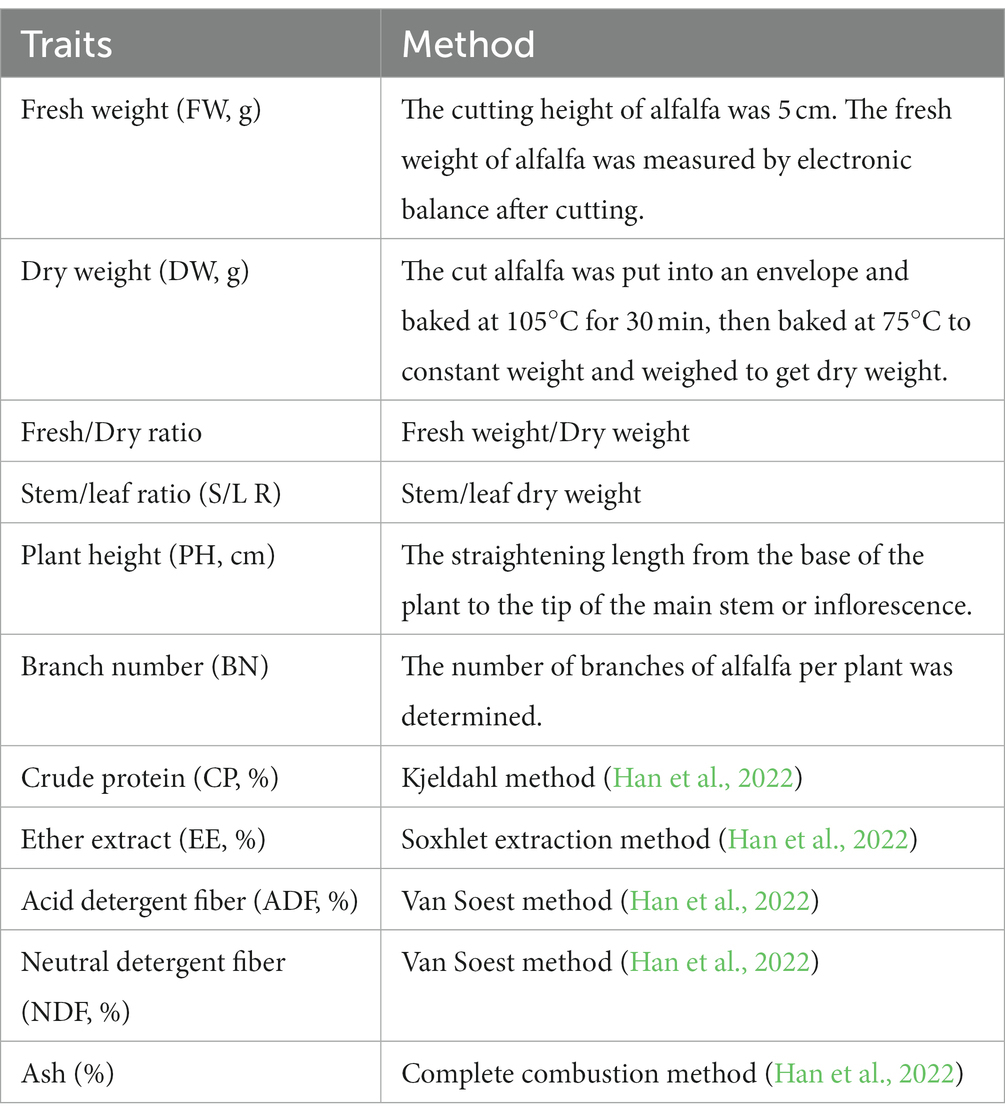- 1School of Resources and Environmental Engineering, Ludong University, Yantai, China
- 2Yantai Forest Resources Monitoring and Protection Service Center, Yantai, China
- 3Livestock and Poultry Genetic Resources Management Station of Guizhou Province, Guiyang, China
Introduction: Salt stress significantly impacts plant growth worldwide. Although alfalfa exhibits some tolerance to salt-alkali soils, the specific salt tolerance levels across different alfalfa varieties remain inadequately understood. For this purpose, we conducted a study to investigate the diversity of agronomic traits of alfalfa (Medicago sativa) under different soil environments in order to elucidate the salt tolerance of 51 alfalfa varieties.
Methods: We chose three different soil conditions for our study: normal conditions in Yantai as control, saline conditions in Yantai with soil salt concentrations ranging from 0.25 to 0.33%, and saline-alkali conditions in Dongying with soil salt concentrations ranging from 0.28 to 0.32%. We chose 51 alfalfa varieties from different sources as our experimental materials. Planting was conducted following a completely randomized block design with three replicates for each variety. Harvesting was performed when the plants reached 50% flowering, cutting them at a height of 5 cm above the ground. Comprehensive assessments encompassed 10 parameters, namely fresh weight, dry weight, stem-leaf ratio, branch count, plant height, crude protein content, crude fat content, acid detergent fiber, neutral detergent fiber, and ash content.
Results: Our findings revealed that the 51 studied alfalfa varieties displayed significant generalized heritability and coefficient of variation, indicating a high level of genetic diversity. Using principal component and cluster analyses, we categorized the varieties into three distinct clusters based on their agronomic traits. Grey correlation degree analysis revealed the commendable performance of Ying st, PI 672734, and Mei zuo across diverse environments. Genotype emerged as a predominant determinant of all parameters, except crude fat, acid detergent fiber, and neutral detergent fiber. Through the application of membership function analysis, PI 672768 emerged as a variety that demonstrated strong tolerance in both saline soil contexts.
Discussion: Despite extensive previous studies indicating Zhong Mu No. 1 as a salt-tolerant alfalfa variety, its performance in this experiment did not distinguish itself. The findings of this study provide a fundamental basis for improving the management of saline-alkali lands and advancing alfalfa cultivation practices.
1. Introduction
Soil salinity is an abiotic stress that significantly affects plant growth. In recent decades, climate change and concurrent water scarcity have contributed to a gradual increase in soil salinization. This phenomenon has spread to over 100 countries worldwide, causing a growing global concern. According to UNESCO and FAO, the extent of saline soil across the globe has expanded to cover an area totaling 932.2 million hectares (Rengasamy, 2006; Mbarki et al., 2020). The widespread occurrence of soil salinization has resulted in a decrease in available arable land, leading to a decline in both food production and pasture areas. Consequently, lower pasture yields have occurred, leading to increased competition for sustenance between humans and animals. This prevalent predicament of limited land use has prompted the cultivation and careful screening of crop varieties with enhanced salt tolerance. This is particularly significant in the context of shrinking land availability, necessitating the selection of plant varieties capable of thriving in saline-alkali environments to improve land utilization efficiency (Zhang et al., 2008; Lu et al., 2021; Zhang et al., 2023).
Given these challenges, there has been a notable increase in global research focused on the cultivation of alfalfa (Medicago sativa). Despite its moderate salt tolerance, alfalfa has shown notable effectiveness in improving saline-alkali soils. Alfalfa, widely distributed in China, has earned the reputation of being the “queen of forage” due to its high protein content, nutritional richness, and prolific yield. However, indigenous alfalfa varieties within China are limited, with a significant proportion being imported from foreign sources. These imported varieties exhibit notable variations in their salt tolerance capabilities. Therefore, it is imperative to investigate the diversity of agronomic traits in the context of saline-alkali soil environments and to identify alfalfa varieties suitable for cultivation under these conditions. These efforts hold the potential to improve the utilization of saline-alkali soils and provide a theoretical foundation for enhancing alfalfa varieties.
Researchers worldwide have made significant progress in unraveling the intricacies of alfalfa’s salt tolerance. For instance, Yu et al. (2021) investigated 20 alfalfa varieties subjected to salt stress during the seedling stage and categorized them based on their response: a high-salt tolerance variety, salt-tolerant, medium salt-tolerant, and salt-sensitive. Similarly, Liang et al. (2017) studied the performance of seven traits across 10 alfalfa varieties under salt stress, pinpointing four varieties distinguished by commendable salt tolerance. Wang et al. (2023) examined germination potential and root length diversities among 29 alfalfa varieties during seed germination to discern five varieties endowed with robust salt tolerance. These studies highlight the recognition of salt tolerance variations among alfalfa varieties and hold substantial potential for refining breeding strategies (Al-Khatib et al., 1992). The results of previous studies provide great inspiration and reference for this experiment (Tavakoli et al., 2019; Benabderrahim et al., 2020; Yu et al., 2021).
Building upon the existing knowledge base, this study delves into the phenotypic and quality attributes of alfalfa cultivated under salt stress. It aspires to ascertain the agronomic trait diversity among 51 alfalfa species across three distinct environments. In this study, we investigated the diversity of agronomic traits in 51 alfalfa species using a gray correlation method with the aim of identifying superior varieties, exploring the relationship between traits, genotypes, and the environment through gene–environment interactions, and finally screening for high-quality alfalfa varieties with pronounced salt tolerance using an affiliation function. The outcomes of this investigation hold the promise of furnishing a theoretical foundation for the selection of salt-tolerant alfalfa varieties, thus advancing the field of alfalfa breeding and variety improvement.
2. Materials and methods
2.1. Test site and test material
The test site for both the Salt Pond and the control group was situated in Zhifu District, Yantai City. The salt pond was irrigated with seawater, resulting in a salt content ranging from 0.25 to 0.33%. In Yantai, the soil’s organic matter content accounted for 7.51% of dry weight, with total nitrogen at 1.187 mg/kg, ammonia nitrogen at 6.39 mg/kg, nitrate nitrogen at 4.89 mg/kg, and total phosphorus at 0.25 mg/kg. The saline-alkali land in Dongying is situated in Kenli District, Dongying City. In the Dongying soil, organic matter content accounted for 5.73% of dry weight, with total nitrogen at 1.04 mg/kg, ammonia nitrogen at 5.38 mg/kg, nitrate nitrogen at 5.87 mg/kg, total phosphorus at 0.29 mg/kg, and a salt content ranging from 0.28 to 0.32%. In this study, “control” refers to the natural environment in Yantai, “Yantai” designates the salt field environment in Yantai, and “Dongying” signifies the saline-alkali land environment in Dongying. Supplementary Table S1 provides a summary of the rainfall, minimum temperature, and maximum temperature data during the experimental period.
2.2. Experimental design
In April 2020, we initiated the germination process by sowing three alfalfa seeds in greenhouse pots. After emergence, we carefully selected and retained a single robust alfalfa seedling to ensure consistent growth conditions. Subsequently, in mid-May 2020, we transplanted 51 distinct alfalfa varieties into three different locations: Yantai, the Yantai salt pond, and Dongying’s saline-alkali land. The details regarding the varieties can be found in Supplementary Table S2. We planted the alfalfa varieties with a spacing of 30 cm between individual plants. The experimental setup included three replicates for each variety, following a randomized complete block design. After 3 months, we scheduled the harvest when the alfalfa plants reached 50% flowering, maintaining a 5 cm elevation above ground level. The experimental setup did not involve fertilization or artificial irrigation practices. Measurement indices and methodologies are detailed in Table 1.
2.3. Statistical analysis
Statistical analysis of the amassed data was conducted using Excel 2022. For correlation analysis and cluster analysis, SPSS 16 was employed. Graphical representation was executed using Origin 9 software.
2.3.1. Genetic diversity analysis
Genetic diversity indices were organized into 10 distinct grades. The initial grade, denoted as Xi > (X + 2σ), was juxtaposed with the tenth grade, Xi > (X + 2σ). The computation of the genetic diversity index, commonly recognized as the Shannon-Weaver diversity index (H′), adhered to the formula H′ = -ΣPilnPi, accommodating a 0.5σ variation between each grade.
Where: X represents the average value of each index, σ signifies the standard deviation of the index, and Pi represents the proportion of specimens within the total cohort displaying grade I characteristics.
2.3.2. Grey relation analysis
Building upon the foundations of grey correlation theory, the study treated the 10 alfalfa traits as a grey system. The construction of the ideal variety, denoted as X0, relied on the optimal values encompassing each individual trait. The ensuing correlation coefficient and correlation degree calculations adhered to established equations (Zeng et al., 2020).
where: |X0(k)-Xi(k)| was the absolute difference between X0 series and Xi series at k, minimink|X0(k)-Xi(k)| was the second level minimum difference, maximaxk|X0(k)-Xi(k)| was the second level maximum difference, ρ was the distinguishing coefficient, the value was considered to be 0.5, Wk was weight, R’i was weighted relevance.
2.3.3. Heritability calculation
The generalized heritability is calculated according to the following formula (Tian et al., 2023).
where is the genotype, is the interaction variance, is the error, is the environment, and is the number of replicates.
2.3.4. Salt tolerance index and membership function value
The assessment of salt tolerance was determined through the utilization of the Salt Tolerance Index, calculated as the ratio of the performance of the tested sample (T test) to that of the control sample (Roshdy et al., 2011). To further refine the analysis, the principles of membership function within the realm of fuzzy mathematics were incorporated. This entailed the standardization of the salt tolerance coefficient, enabling a more comprehensive and nuanced evaluation of the salt tolerance characteristics of the examined varieties (Jin et al., 2018).
Where Xj represents the salt tolerance index of j index of the i variety, and Xmax and Xmin, respectively, represent the maximum and minimum values of the index.
The weight of each comprehensive index:
Comprehensive salt tolerance:
where, Wj represents the importance or weight of the j-th comprehensive indicator among all indicators, Pj represents the contribution rate of the j-th comprehensive indicator for each material, and D represents the comprehensive evaluation value of heat tolerance obtained by evaluating each material under high temperature stress using comprehensive indicators.
3. Results
3.1. Analysis of agronomic trait diversity of alfalfa in different environments
Under controlled conditions, the coefficient of variation for the 51 studied alfalfa varieties ranged from 3.78 to 70.47% (Table 2). The highest coefficient of variation was observed in dry weight (DW) at 70.47%, while the lowest was recorded in CP at 3.78%. Assessing the genetic diversity index, all 10 physiological indices showed values exceeding 1, indicating significant genetic diversity among the alfalfa varieties. Notably, the highest genetic diversity was observed in CP and ADF at 1.98.

Table 2. Summary of mean, standard deviation, coefficient of variation, and genetic diversity for 10 agronomic traits of 51 alfalfa species in Yantai’s control environment.
Within the Yantai environment, the coefficient of variation across agronomic traits within the 51 alfalfa specimens ranged from 3.91 to 69.92% (Table 3). The maximal coefficient of variation was noted in DW at 69.92%, while the minimum coefficient was witnessed in CP at 3.91%. Genetic diversity exhibited alterations, with increments observed in FW, DW, PH, ADF and ash content. Conversely, reductions were noted in BN, S/L R, CP, and EE. Notably, the genetic diversity of NDF remained constant, with the highest genetic diversity observed in ash content at 2.02.

Table 3. Summary of mean, standard deviation, coefficient of variation, and genetic diversity for 10 agronomic traits of 51 alfalfa species in Yantai’s salt pond environment.
In Dongying, the coefficient of variation for the 51 agronomic traits of alfalfa ranged from 3.81 to 74.09% (Table 4). The lowest coefficient of variation was found in CP at 3.81%, while the highest was observed in DW at 74.09%. In comparison to the Yantai environment, the genetic diversity index in Dongying showed increased genetic diversity in FW, DW, EE, NDF, and ADF. However, genetic diversity trends diverged, with declines observed in BN, S/L R, CP, and ash content.

Table 4. Summary of mean, standard deviation, coefficient of variation, and genetic diversity for 10 agronomic traits of 51 alfalfa species in Dongying’s saline-alkali land.
In contrast to the control conditions, exposure to the saline environment resulted in significant changes. Specifically, DW, FW, PH, and S/L R exhibited reductions in the salt-affected environment. Conversely, BN, CP, and ash content displayed increases. Conversely, limited fluctuations were observed in EE, ADF, and NDF. Furthermore, compared to the control, the mean values of DW, FW, PH, and S/L R declined by 24.68, 24.45, 19.15, and 15.18%, respectively, in Yantai. At the same time, BN, CP, and ash content exhibited increases of 10.81, 10.04, and 19.94%, respectively. Analogous trends were observed in the Dongying environment, where DW, FW, PH, and S/L R underwent reductions of 24.45, 24.68, 19.15, and 15.18% respectively, while BN, CP, and ash content experienced increments of 13.51, 10.04, and 19.94%, respectively.
3.2. Correlation analysis of agronomic traits in diverse alfalfa environments
We conducted a comprehensive correlation analysis involving the diverse set of 51 alfalfa species under controlled conditions, revealing intricate relationships among the evaluated traits (Figure 1A). The results revealed significant correlations with FW showing positive associations with BN, S/L R, EE, and ADF. Meanwhile, DW showed positive correlations with FW, BN, S/L R, and ADF, while EE was positively correlated with ADF. Furthermore, CP displayed positive correlations with EE and was as significantly positively correlated with ash content. Notably, a negative correlation was observed between CP and NDF, while EE revealed a notable negative correlation with NDF and positive correlation with Ash content. The ADF content exhibited a positive correlation with NDF, while a significant negative correlation was observed between NDF and ash content.
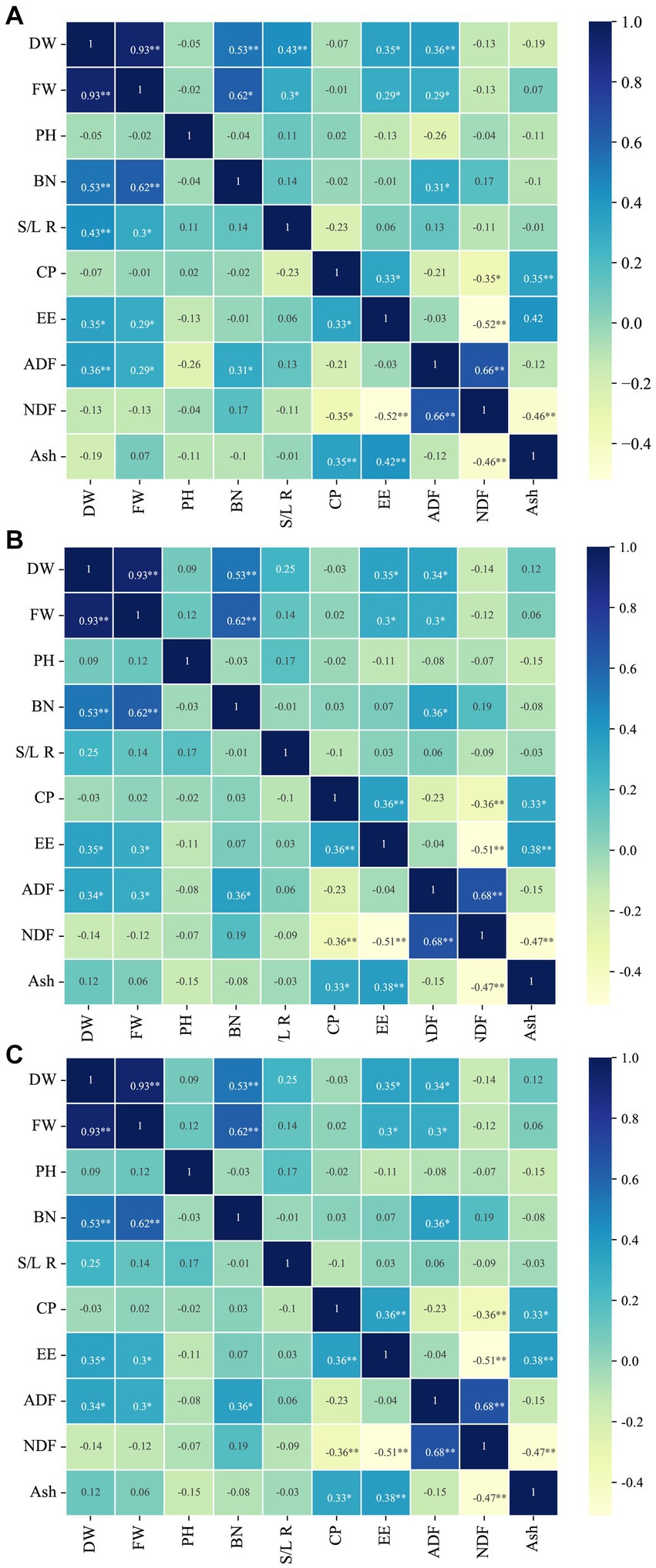
Figure 1. Correlation analysis of 10 agronomic traits of 51 alfalfa species under (A) normal environment in Yantai, (B) salt pond in Yantai, and (C) saline soil in Dongying.
In the Yantai environment, we presented a thorough correlation analysis among the 51 agronomic traits, providing insights into trait interactions (Figures 1B,C and Figures 2). Importantly, differences from the control environment become apparent, with DW showed a significant positive correlation with EE and ADF content. Conversely, in the saline soil environment of Dongying, BN displayed a positive correlation with ADF. Notably, the content of CP and NDF demonstrated significant negative correlations when contrasted with the control environment, diverging from other correlations which largely mirrored those of the control environment. Additionally, it is worth noting that PH did not show significant correlation with the other measured traits in this context.
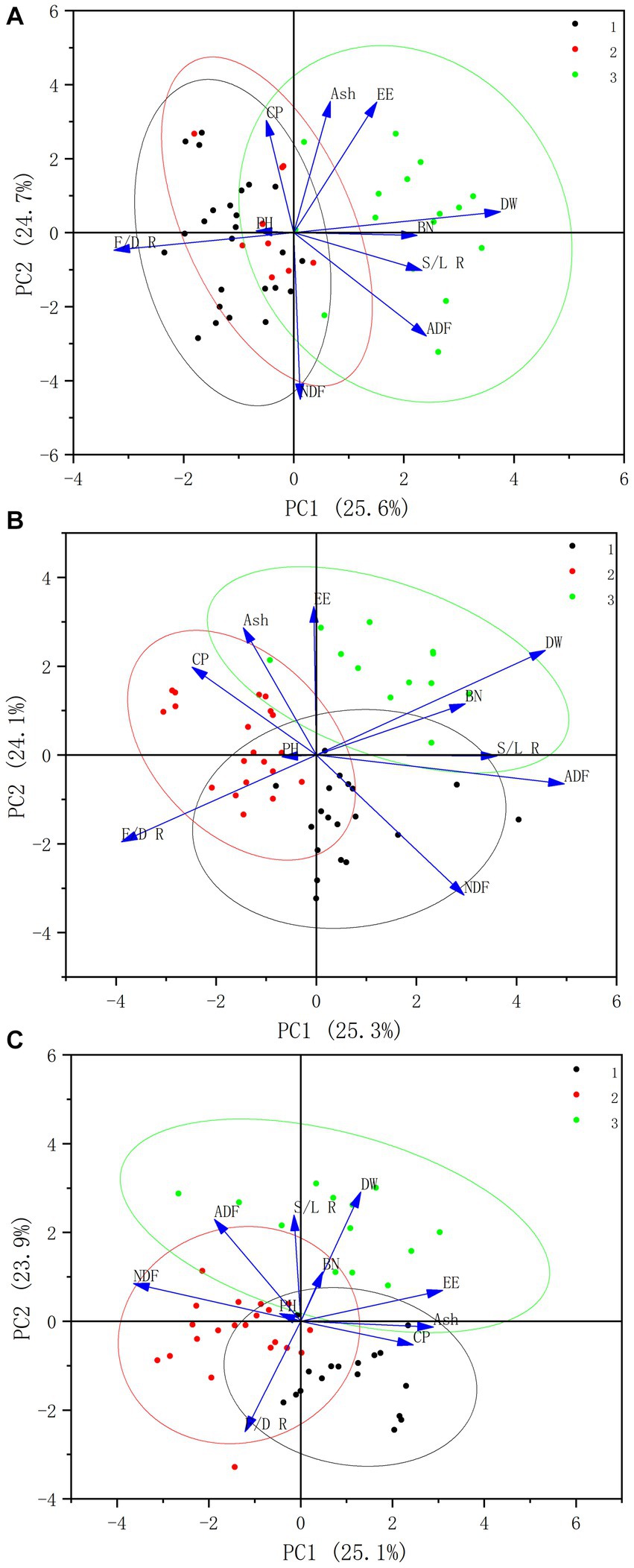
Figure 2. Results of cluster analysis and principal component analysis of agronomic traits of alfalfa under (A) control environment, (B) salt pond in Yantai, and (C) saline soil in Dongying.
3.3. Principal component analysis and cluster analysis
Utilizing advanced analytical techniques, we employed principal component analysis (PCA) and cluster analysis to gain deeper insights into the complex interrelationships among the agronomic traits of diverse alfalfa species across different environments.
In controlled conditions, we enhanced the cluster analysis by converting FW into the Fresh-to-Dry Ratio (F/D R). We then applied the Ward method to cluster the standardized results of the 51 agronomic traits of alfalfa. As a result, the alfalfa varieties coalesced into three distinct groups (Table 5). The primary group comprised 25 varieties, characterized by elevated F/D R, PH, Ash content, and NDF. The secondary group consisted of 10 varieties, distinguished by the highest average PH and Ash content. Meanwhile, the tertiary group, encompassing 16 varieties, showcased heightened average values for DW, BN, S/L R, EE, and ADF. The insights obtained from principal component analysis supported these findings. Principal component 1 explained 25.6% of the total trait variation, and principal component 2 accounted for 24.7% of the overall variation in the controlled environment.

Table 5. Average values of 10 agronomic traits of 51 alfalfa species across three groups in Yantai’s normal environment.
In the Yantai environment, similar procedures led to the clustering of the 51 alfalfa species into three distinct groups (Table 6). The primary cluster encompassed 19 varieties distinguished by elevated PH, ADF, and NDF. The secondary cluster, containing 20 varieties, exhibited the highest Fresh-to-Dry Ratio (F/D R) and average CP. Conversely, the tertiary cluster, composed of 12 varieties, exhibited superior average values for DW, BN, S/L R, EE, and Ash content. Principal component analysis reaffirmed these findings, with principal component 1 and 2 explained 25.3 and 24.1% of the total trait variation, respectively.

Table 6. Average values of 10 agronomic traits of 51 alfalfa species across three groups in Yantai’s salt pond environment.
In the Dongying environment, principal component analysis also revealed intricate patterns. Principal component 1 and 2 collectively expounded 25.1 and 23.9% of the total trait variation, respectively. Cluster analysis led to the categorization of the 51 alfalfa species into three discernible groups (Table 7). The primary group, constituted of 17 varieties, exhibited the highest average values for CP, ADF, NDF, and Ash content. Meanwhile, the secondary group, featuring 21 varieties, was distinguished by superior average F/D R and PH. The tertiary group, housing 13 varieties, displayed heightened average values for DW, BN, S/L R, and EE.

Table 7. Average values of 10 agronomic traits of 51 alfalfa species across three groups in Dongying’s saline-alkali land.
The integration of principal component analysis and cluster analysis elucidated the intricate trait associations and groupings across distinct environments, thereby affording valuable insights into the varietal behavior of alfalfa under differing conditions.
3.4. Screening of excellent forage performance varieties
The process of identifying superior alfalfa varieties, enriched by rigorous analytical methods, aimed to reveal strains that exhibited exceptional performance across various traits and environments. To create a representative ideal variety designated as X0, each attribute was optimized to maximize values, except for ADF, NDF, and Ash, where the goal was to minimize values. This approach facilitated the normalization of data through the initial value method, enabling the computation of both minimink|X0(k)-Xi(k)| and maximaxk|X0(k)-Xi(k)|.
Subsequently, the weighted correlation degree was employed as a discerning criterion for the stratification of the alfalfa varieties (Table 8). The outcomes of this process revealed the top five ranked varieties across the entire spectrum. In a broader context, the Ying st, PI 672734, Mei zuo, Gan nong NO.6 and Nan mu 501 emerged as prominently ranked, indicating their superior quality across diverse traits. This trend persisted within the Yantai environment, where Ying st, PI 672734, Mei zuo, Gan nong No.6 and Xiang yang No.6 garnered the highest acclaim. Likewise, within the Dongying environment, the elite rankings included PI 672734, Ying st, Nan mu 501, Gan Nong 6, and Mei zuo. It is worth noting the consistent excellence exhibited by Ying st, PI 672734, Gan nong No.6, and Mei zuo, confirming their exceptional qualities across all three distinct environments, firmly establishing them as high-caliber alfalfa varieties.
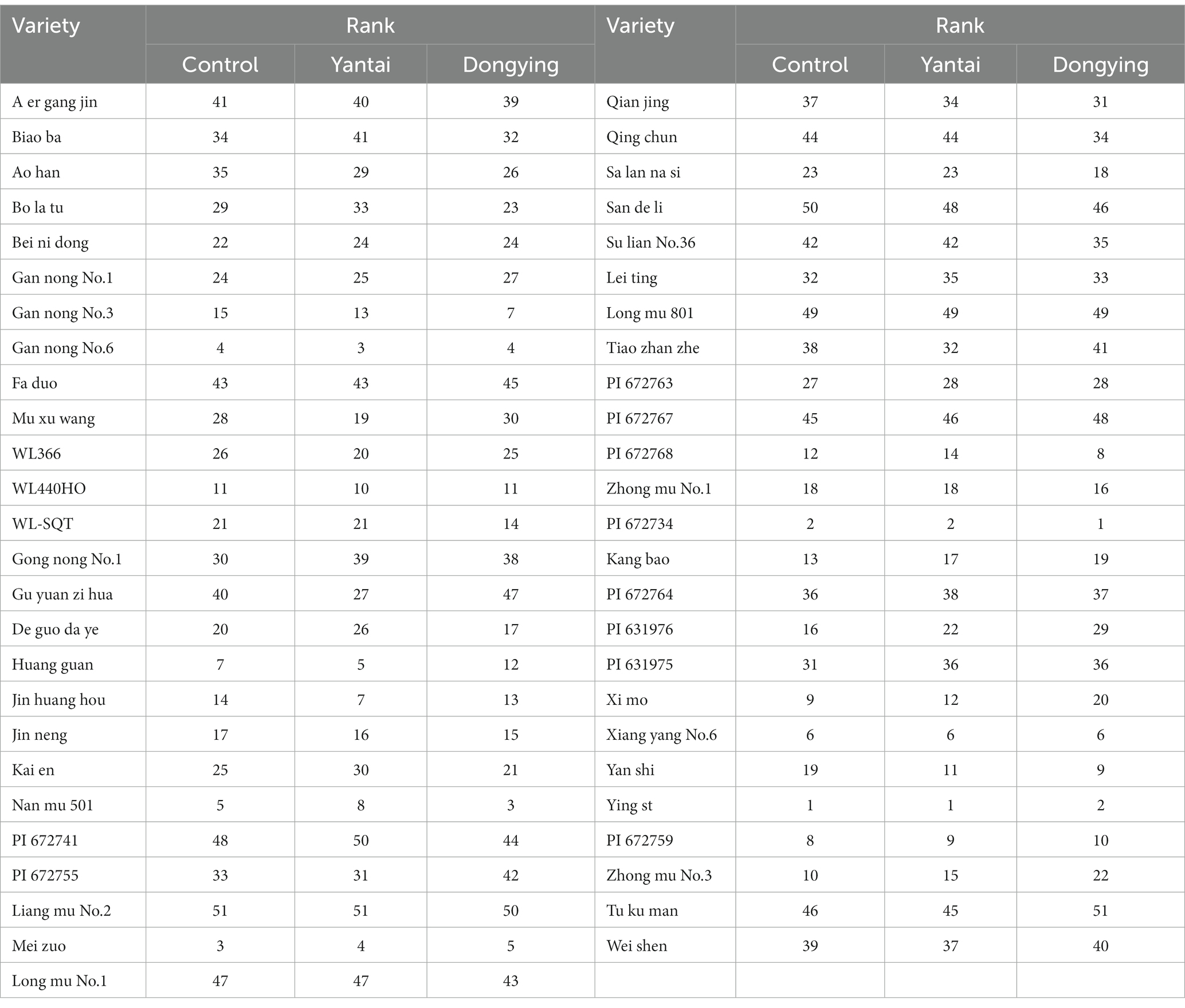
Table 8. Ranking of 51 alfalfa species in three environments based on grey correlation degree analysis results.
The meticulous process of strain selection, supported by comprehensive analytical techniques, serves to underscore the significance of Yingst, PI 672734, Gan nong No.6 and Mei zuo as robust candidates for continued agricultural propagation and advancement. This discerning approach aligns with the pursuit of enhancing alfalfa cultivation while attaining optimal yields and performance across varying conditions.
3.5. Genotype-by-environment (G × E) analysis and identification of salt-tolerant varieties
A thorough investigation of G × E interactions, supported by meticulous data analysis (Tables 9, 10), formed the basis for assessing 10 distinct agronomic traits in alfalfa. The findings underscored the undeniable influence of genotype on the majority of traits (p < 0.01). Nevertheless, traits such as F/D R, EE, ADF, and NDF remained unaffected by the environment, thus indicating the inherent genetic stability of these traits in the face of environmental variability. Conversely, crucial traits including DW, PH, BN, S/L R, CP and ash content were significantly impacted by environmental conditions. This substantiated that the genetic integrity of F/D R, EE, ADF, and NDF endured regardless of external environmental factors. Interestingly, an interaction between genetic makeup and environmental factors was observed, especially concerning DW and ash content. Notably, the relative significance ranking of the six traits significantly influenced by the genotypic environment emerged as follows: Ash > CP > DW > S/L R > PH > BN in Yantai; Ash > DM > CP > S/L R > PH > BN in Dongying.
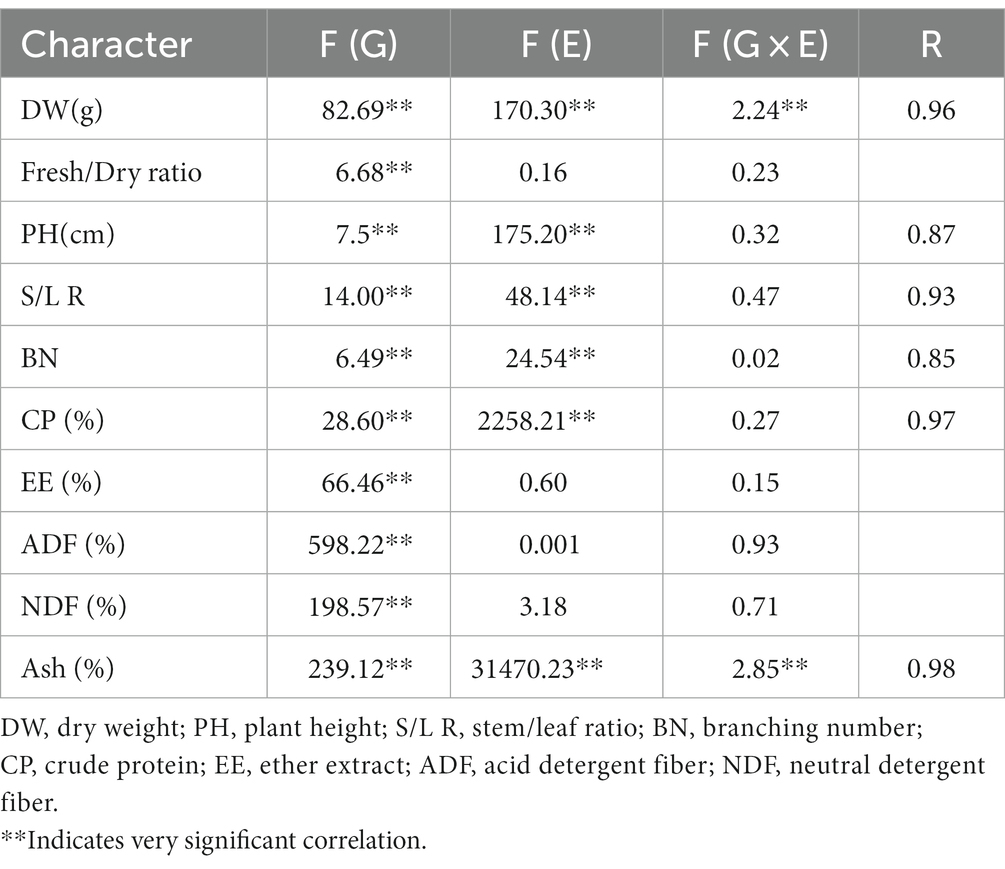
Table 9. Two-factor analysis of variance of 51 alfalfa species in Yantai’s normal environment and salt pond environment based on 10 agronomic traits.
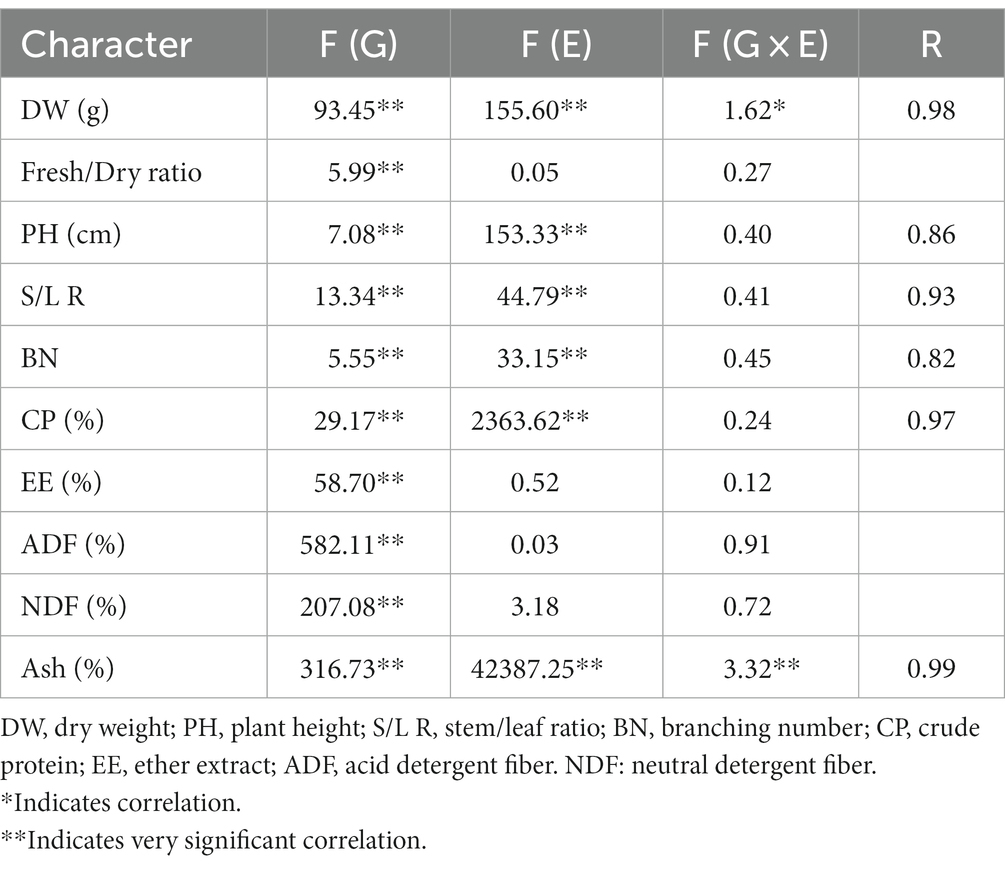
Table 10. Two-factor analysis of variance of 51 alfalfa species in Yantai’s normal environment and Dongying’s saline soil environment based on 10 agronomic traits.
To holistically evaluate the salt tolerance of alfalfa, the six agronomic traits concurrently influenced by both genotype and environment were harnessed as evaluative indices: DW, PH, BN, S/L R, CP, and Ash. Transmuting these attributes into a salt tolerance index, a membership function was invoked for comparison. The resulting rankings were presented in Table 11, revealing the relative standing of each trait. The hierarchy of traits significantly influenced by the genotypic environment mirrored the following sequence: Ash > DW > CP > S/L R > PH > BN.
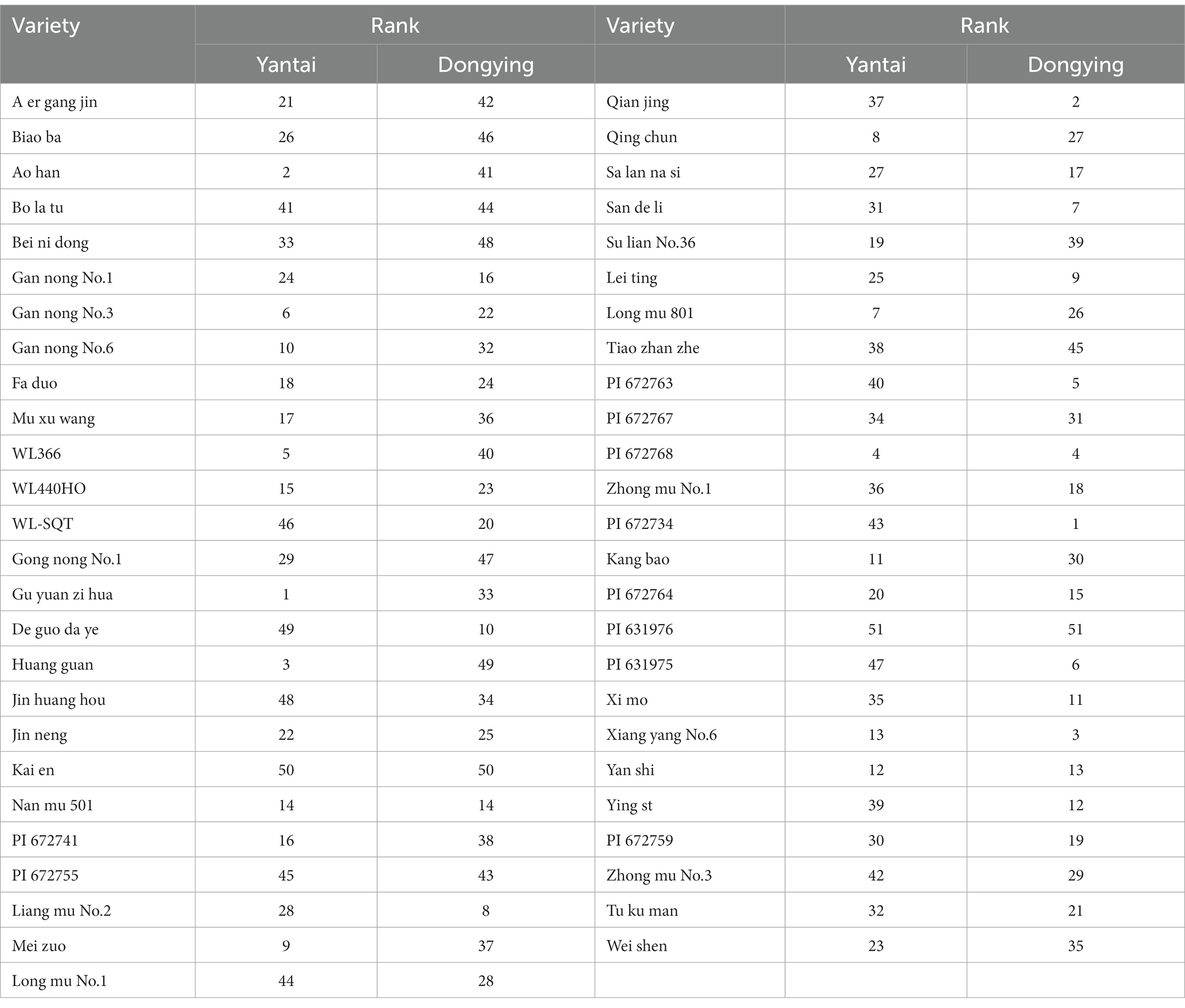
Table 11. Ranking of 51 alfalfa species in two salt environments based on two-factor analysis of variance results and membership function theory.
Within the Yantai environment, excellent salt-tolerant varieties were Gu yuan zi hua, Ao han, Huang guan, PI 672768, and WL366. Similarly, the ranking of salt-tolerant varieties in the Dongying environment were lead PI 672734, Qian jing, Xiang yang No. 6, PI 672768, and PI 672763. This discerning analysis substantiates the multifaceted nature of salt tolerance within the gamut of alfalfa species, offering invaluable insights into the adaptation and performance of these varieties across contrasting environments.
4. Discussion
4.1. Genetic diversity and environmental adaptation
The phenomenon of long-term natural selection has endowed plants with a relatively stable phenotype and a rich reservoir of genetic diversity (Wu et al., 2018). As evidenced by the substantial divergence in growth parameters, different varieties of the same species exhibit distinctive responses to varied environments (An et al., 2021). This divergence becomes notably pronounced under the stress of salt-induced conditions, where the growth of salt-sensitive varieties is impeded, ultimately posing a threat of plant mortality (Li et al., 2010). Central to assessing alfalfa quality are agronomic traits encompassing DW, PH, and nutrient composition (Akdeniz et al., 2019). The statistical analysis of 51 alfalfa traits across three distinct environments underscores the elevated genetic diversity and coefficient of variation inherent to alfalfa’s adaptive repertoire across these varied settings.
4.2. Salt stress and genetic diversity
Salt stress stands as a formidable abiotic factor that profoundly influences alfalfa’s growth and development. Prior studies, predominantly conducted under simulated salt stress conditions, offer a myriad of insights into alfalfa’s salt tolerance (Annicchiarico, 1992; Tucak et al., 2008). However, a divergence often exists between simulated stress and actual saline-alkali conditions (Qados, 2011; Mann et al., 2019). Correspondingly, Al-Khatib et al. (1992) observed a heightened genetic diversity in alfalfa under salt stress. In congruence with these findings, our experiment illuminates that the genetic diversity of more than half the traits underwent augmentation in response to salt stress. Generally, the imposition of salt stress leads to escalated osmotic pressure in the soil, impairing water absorption and exerting a detrimental impact on alfalfa growth. Consequently, a decrease in FW, DW, and PH is an anticipated outcome. These outcomes are in line with previous research that posits salt stress amplifies the S/L R of alfalfa, thereby enhancing overall quality a trend corroborated by our experiment’s results.
4.3. Nutrient content and salt stress
Reinforcing the intricate relationship between nutrient content and salt stress, Akdeniz et al. (2019) establish a direct correlation between high CP levels and elevated Ash content. Additionally, Ferreira et al. (2015) and Wan et al. (2023) unveil salt stress’s role in augmenting CP content while diminishing ADF and NDF concentrations. Nonetheless, discrepancies persist due to variable factors including alfalfa variety and experimental locale.
4.4. High quality alfalfa varieties
Grey system theory can standardize all kinds of indicators and assign weight coefficients to them, which can not only effectively overcome the limitations caused by single indicators, but also objectively and accurately conduct comprehensive evaluation of alfalfa varieties (lines), and has been widely used in comprehensive evaluation of forage. Wang et al. (2021) According to the study of 8 kinds of alfalfa quality traits by grey correlation degree, WL358, WL440HQ, WL656HQ, and WL366HQ are excellent alfalfa varieties. According to the study of 8 kinds of alfalfa quality traits by grey correlation degree, WL358, WL440HQ, WL656HQ, and WL366HQ are excellent alfalfa varieties. Lu et al. (2021) also evaluated 12 kinds of alfalfa by grey correlation degree and found that WL656HQ, WL525, and WL440HQ were relatively excellent varieties, indicating that grey correlation degree analysis is a commonly used and reliable evaluation method for alfalfa evaluation. Li et al. (2021) found that Ying st performed better in the study on the introduction of alfalfa in Yunnan province, and Ying st performed better in the three environments in this experiment, while Quan et al. (2023) found that Ying st was not prominent in the variety comparison test in Gansu province. This is different from the results of this study, and the reason for this result is the different environment of the planting site.
4.5. G × E interaction and salt tolerance evaluation
A pivotal facet in plant agronomy lies in comprehending the intricate interplay between genotype and environment. Such interactions significantly impact agronomic traits across varied plant species, including wheat, oats, and alfalfa (Purchase, 1997; Peterson et al., 2005; Qiu et al., 2023; Tian et al., 2023). Distinct acidic soils further underscore genotype’s pivotal role in shaping alfalfa traits, as elucidated by Achir et al. (2020), who deem environmental influence on alfalfa yield as paramount. In our study, genotype emerged as the principal driver of diverse agronomic traits in control and saline-alkali soil environments. Conversely, the environment significantly affected multiple traits, excluding F/D R, EE, Acid detergent Fiber, and Neutral detergent Fiber. Interestingly, the traits influenced by genotype and environment generally exhibited higher average generalized heritability, reflecting predominant genetic influence. However, as a comprehensive quantitative trait, salt tolerance is a complex trait influenced by many genetic and non-genetic factors (Ashraf and Foolad, 2013), and it is difficult for a single trait to reflect the salt tolerance of plants, comprehensive salt tolerance evaluation demands the amalgamation of morphological, physiological, and biochemical indices (El-Hendawy et al., 2005; Badran et al., 2015; Guo et al., 2022). In the past, Al-Khatib et al. (1994) believed that branch length could be used as an evaluation index of salt-tolerance of alfalfa, while Tavakoli et al. (2019) and Benabderrahim et al. (2020) believed that reliable results could be obtained only when the results of multiple indexes were comprehensively considered. In this experiment, G × E analysis found that only part of the traits studied were affected by environmental factors. Therefore, we used the membership function method to comprehensively evaluate these traits and finally screened out Gu yuan zi hua, Ao han, Huang guan, PI 672768, WL366, PI 672734, Qian jing, Xiang yang No. 6, and PI 672763 excellent salt-tolerant varieties.
In essence, this study contributes to our understanding of alfalfa’s genetic diversity, environmental responsiveness, and salt tolerance. The interplay between genotype and environment profoundly shapes the alfalfa’s performance, offering insights into suitable varieties for saline-alkali land improvement. By effectively marrying analytical techniques, this research aligns with the overarching goal of optimizing alfalfa cultivation and bolstering agricultural productivity. The screened high-quality purple alfalfa varieties can provide materials for the breeding of purple alfalfa varieties, and at the same time, high-quality salt-tolerant varieties have value in future saline-alkali land improvement.
5. Conclusion
In this study, an exhaustive exploration of agronomic traits across 51 alfalfa varieties under three distinct environments was conducted, yielding valuable insights into the plant’s genetic diversity and adaptive capabilities. The observed richness in genetic diversity across the diverse array of agronomic traits underscores the inherent flexibility of alfalfa to respond to varying conditions. Among the plethora of varieties assessed, four standouts emerged: Yingst, PI 672734, Gan nong No.6 and Mei zuo, all manifesting exceptional traits across the different environments studied.
Furthermore, the assessment of salt tolerance in alfalfa under diverse saline and alkaline conditions revealed intriguing nuances. Contrary to conventional assumptions, the highest-performing alfalfa varieties did not universally exhibit superior salt tolerance. An exemplary case is PI 672768, which demonstrated remarkable salt tolerance despite not being classified among the highest-performing varieties under normal conditions. This finding underscores the complexity of salt tolerance mechanisms within alfalfa varieties.
The outcomes of this study hold significant implications for the selection and breeding of alfalfa varieties optimized for diverse environments. The elucidation of genetic diversity, coupled with a nuanced understanding of salt tolerance, lays the foundation for more effective alfalfa variety selection and improvement strategies. Ultimately, these findings contribute to the advancement of sustainable agriculture practices by harnessing the genetic potential of alfalfa to thrive in challenging and diverse conditions.
Data availability statement
The original contributions presented in the study are included in the article/Supplementary material, further inquiries can be directed to the corresponding author.
Author contributions
SF: Investigation, Resources, Writing – review & editing. JC: Data curation, Writing – original draft. JM: Resources, Writing – original draft. MZ: Funding acquisition, Project administration, Supervision, Writing – review & editing.
Funding
The author(s) declare financial support was received for the research, authorship, and/or publication of this article. This research was funded by National Natural Science Foundation of China, grant number 3190139.
Conflict of interest
The authors declare that the research was conducted in the absence of any commercial or financial relationships that could be construed as a potential conflict of interest.
Publisher’s note
All claims expressed in this article are solely those of the authors and do not necessarily represent those of their affiliated organizations, or those of the publisher, the editors and the reviewers. Any product that may be evaluated in this article, or claim that may be made by its manufacturer, is not guaranteed or endorsed by the publisher.
Supplementary material
The Supplementary material for this article can be found online at: https://www.frontiersin.org/articles/10.3389/fsufs.2023.1278913/full#supplementary-material
References
Achir, C., Annicchiarico, P., Pecetti, L., Khelifi, H. E., and Laouar, M. (2020). Adaptation patterns of sixteen alfalfa (Medicago sativa L.) cultivars across contrasting environments of Algeria and implications for the crop improvement. Ital. J. Agron. 15, 57–62. doi: 10.4081/ija.2020.1578
Akdeniz, H., Hosaflioglu, I., Koç, A., Hossain, A., Islam, M. S., Iqbal, M. A., et al. (2019). Evaluation of herbage yield and nutritive value of eight forage crop species. Appl. Ecol. Environ. Res. 17, 5571–5581. doi: 10.15666/aeer/1703_55715581
Al-Khatib, M., Mcneilly, T., and Collins, J. (1992). The potential of selection and breeding for improved salt tolerance in lucerne (Medicago sativa L.). Euphytica 65, 43–51. doi: 10.1007/BF00022198
Al-Khatib, M. M., McNeilly, T., and Collins, J. C. (1994). Between and within cultivar variability in salt tolerance in lucerne, (Medicago sativa L.). Genet. Resour. Crop. Evol. 41, 159–164. doi: 10.1007/BF00051632
An, Y., Gao, Y., Tong, S., and Liu, B. (2021). Morphological and physiological traits related to the response and adaption of Bolboschoenus Planiculmis seedlings grown under salt-alkaline stress conditions. Front. Plant Sci. 12:567782. doi: 10.3389/fpls.2021.567782
Annicchiarico, P. (1992). Cultivar adaptation and recommendation from alfalfa trials in Northern Italy. J. Genet. Breed. 46:269.
Ashraf, M., and Foolad, M. R. (2013). Crop breeding for salt tolerance in the era of molecular markers and marker-assisted selection. Plant Breed. 132, 10–20. doi: 10.1111/pbr.12000
Badran, A. E., ElSherebeny, E. A. M., and Salama, Y. A. (2015). Performance of some alfalfa cultivars under salinity stress conditions. J. Agric. Sci. 7:281. doi: 10.5539/jas.v7n10p281
Benabderrahim, M. A., Guiza, M., and Haddad, M. (2020). Genetic diversity of salt tolerance in tetraploid alfalfa (Medicago sativa L.). Acta Physiol. Plant. 42, 1–11. doi: 10.1007/s11738-019-2993-8
el-Hendawy, S. E., Hu, Y., Yakout, G. M., Awad, A. M., Hafiz, S. E., and Schmidhalter, U. (2005). Evaluating salt tolerance of wheat genotypes using multiple parameters. Eur. J. Agron. 22, 243–253. doi: 10.1016/j.eja.2004.03.002
Ferreira, J., Cornacchione, M., Liu, X., and Suarez, D. (2015). Nutrient composition, forage parameters, and antioxidant capacity of alfalfa (Medicago sativa L.) in response to saline irrigation water. Agriculture 5, 577–597. doi: 10.3390/agriculture5030577
Guo, S., Ma, X., Cai, W., Wang, Y., Gao, X., Fu, B., et al. (2022). Exogenous proline improves salt tolerance of alfalfa through modulation of antioxidant capacity, ion homeostasis, and proline metabolism. Plants (Basel) 11:2994. doi: 10.3390/plants11212994
Han, F., Fu, G., Yu, C., and Wang, S. (2022). Modeling nutrition quality and storage of forage using climate data and normalized-difference vegetation index in alpine grasslands. Remote Sens. 14:3410. doi: 10.3390/rs14143410
Jin, Y., Wang, Y., Chen, J., Guo, Q., and Xu, B. (2018). Comparison of salt tolerance of 14 alfalfa hybrid combinations. Pratacult. Sci. 35, 2931–2939. doi: 10.11829/j.issn.1001-0629.2017-0497
Li, R., Shi, F., Fukuda, K., and Yang, Y. (2010). Effects of salt and alkali stresses on germination, growth, photosynthesis and ion accumulation in alfalfa (Medicago sativa L.). Soil Sci. Plant Nutr. 56, 725–733. doi: 10.1111/j.1747-0765.2010.00506.x
Li, Y., Zhang, M., Ren, J., Yi, J., Li, X., Yang, Y., et al. (2021). New variety comparison experiment medicago sativa l. in subtropical zone of Yunnan province. J. West China For. Sci. 50, 82–86. doi: 10.16473/j.cnki.xblykx1972.2021.03.011
Liang, X., Qi, Y., Li, Y., Shi, Y., Cao, W., Li, W., et al. (2017). Comprehensive evaluation on salinity performance of 10 alfalfa varieties by comprehensive index and gray correlation methods. Crops 2017:6. doi: 10.16035/j.issn.1001-7283.2017.04.008
Lu, X., Wang, X., Yang, W., Wang, L., Zhang, X., and Zhao, Y. (2021). Production performance and quality evaluation of 12 alfalfa varieties (lines) in Tai 'an, Shandong Province. Shandong J. An. Sci. Vet. Med. 42, 1–6. doi: 10.3969/j.issn.1007-1733.2021.01.001
Mann, A., Kaur, G., and Kumar, A., Sanwal, SK., Singh, J., and Sharma, P. (2019). Physiological response of chickpea (Cicer arietinum L.) at early seedling stage under salt stress conditions. Legume Res. Int. J., 42, 625–632. doi: 10.18805/LR-4059
Mbarki, S., Skalicky, M., Talbi, O., Chakraborty, A., Hnilicka, F., Hejnak, V., et al. (2020). Performance of Medicago sativa grown in clay soil favored by compost or farmyard manure to mitigate salt stress. Agronomy 10:94. doi: 10.3390/agronomy10010094
Peterson, D. M., Wesenberg, D. M., Burrup, D. E., and Erickson, C. A. (2005). Relationships among agronomic traits and grain composition in oat genotypes grown in different environments. Crop Sci. 45, 1249–1255. doi: 10.2135/cropsci2004.0063
Purchase, J. L. (1997). Parametric analysis to describe genotype x environment interaction and yield stability in winter wheat. [Doctoral dissertation]. University of the Free State.
Qados, A. (2011). Effect of salt stress on plant growth and metabolism of bean plant Vicia faba (L.). J. Saudi Soc. Agric. Sci. 10, 7–15. doi: 10.1016/j.jssas.2010.06.002
Qiu, Y., Wang, Y., Fan, Y., Hao, X., Li, S., and Kang, S. (2023). Root, yield, and quality of alfalfa affected by soil salinity in Northwest China. Agriculture 13:750. doi: 10.3390/agriculture13040750
Quan, J., Li, X., Gan, H., Ma, Y., and Wang, P. (2023). Adaptability of 43 medicago sativa varieties in the irrigated agricultural area of Zhangye, Gansu province. Pratacult. Sci. 40, 1888–1901. doi: 10.11829/j.issn.1001-0629.2022-0893
Rengasamy, P. (2006). World salinization with emphasis on Australia. J. Exp. Bot. 57, 1017–1023. doi: 10.1093/jxb/erj108
Roshdy, A. E. D., Alebidi, A., Almutairi, K., Al-Obeed, R., and Elsabagh, A. (2011). The effect of salicylic acid on the performances of salt stressed strawberry plants, enzymes activity, and salt tolerance index. Agronomy 11:775. doi: 10.3390/agronomy11040775
Tavakoli, M., Poustini, K., Besharati, H., and Ali, S. (2019). Variable salinity responses of 25 alfalfa genotypes and comparative salt-response ion distribution. Russ. J. Plant Physiol. 66, 231–239. doi: 10.1134/S1021443719020158
Tian, Z., Yang, Z., Lu, Z., Luo, B., Hao, Y., Wang, X., et al. (2023). Effect of genotype and environment on agronomical characters of alfalfa (Medicago sativa L.) in a typical acidic soil environment in Southwest China. Front. Sust. Food Syst. 7:1144061. doi: 10.3389/fsufs.2023.1144061
Tucak, M., Popović, S., Čupić, T., Grljušić, S., Bolarić, S., and Kozumplik, V. (2008). Genetic diversity of alfalfa (Medicago spp.) estimated by molecular markers and morphological characters. Period. Biol. 110, 243–249.
Wan, W., Liu, Q., Zhang, C., Li, K., Sun, Z., Li, Y., et al. (2023). Alfalfa growth and nitrogen fixation constraints in salt-affected soils are in part offset by increased nitrogen supply. Front. Plant Sci. 14:358. doi: 10.3389/fpls.2023.1126017
Wang, X., Wang, L., Yang, W., Pan, X., Zhao, Y., Jiang, H., et al. (2021). Comprehensive evaluation of alfalfa quality based on near infrared spectroscopy methods. Chin. J. Grassland 43, 38–44. doi: 10.16742/j.zgcdxb.20190253
Wang, M.Zhao, Z., Hu, Z., and Wu, X.Gong, M.He, Z., et al. (2023). Evaluation of heat tolerance of local germplasm resources of leek in Guangxi based on membership function and cluster analysis. Southw. China J. Agric. Sci., 36, 541–549. doi: 10.16213/j.cnki.scjas.2023.3.012
Wu, X. M., Guo, P., Chi, H. W., Fang, Z. H., Shi, Y. H., Wang, Y. Q., et al. (2018). Diversity analysis of phenotypic traits and quality characteristics of alfalfa (Medicago sativa) introducted from abroad germplasm resources. J. Plant Gen. Res. 19, 103–111. doi: 10.13430/j.cnki.jpgr.2018.01.012
Yu, R., Wang, G., Yu, X., Li, L., Li, C., Song, Y., et al. (2021). Assessing alfalfa (Medicago sativa L.) tolerance to salinity at seedling stage and screening of the salinity tolerance traits. Plant Biol. 23, 664–674. doi: 10.1111/plb.13271
Zeng, L. S., Li, P. Y., Sun, X. F., and Sun, Z. J. (2020). A multi-trait evaluation of drought resistance of bermudagrass (Cynodon dactylon) germplasm from different habitats in Xinjiang province. Acta Pratacul. Sin. 29, 155–169. doi: 10.11686/cyxb2019486
Zhang, C., Chen, Y., Xu, F., Song, S., and Zhao, N. (2008). Study on the alfalfa cultivation in the young poplar growing Medicago sativa. Grassland Turf 128, 63–65. doi: 10.13817/j.cnki.cyycp.2008.03.017
Keywords: agronomic characters, varietal assessment, forage breeding, salt stress, genotype and environment interaction
Citation: Fan S, Chen J, Mu J and Zhang M (2023) Genetic diversity and salt tolerance assessment of 51 alfalfa (Medicago sativa) varieties under saline soil conditions. Front. Sustain. Food Syst. 7:1278913. doi: 10.3389/fsufs.2023.1278913
Edited by:
Zhou Li, Guizhou University, ChinaReviewed by:
Jibiao Fan, Yangzhou University, ChinaAsif Ameen, Pakistan Agricultural Research Council, Pakistan
Copyright © 2023 Fan, Chen, Mu and Zhang. This is an open-access article distributed under the terms of the Creative Commons Attribution License (CC BY). The use, distribution or reproduction in other forums is permitted, provided the original author(s) and the copyright owner(s) are credited and that the original publication in this journal is cited, in accordance with accepted academic practice. No use, distribution or reproduction is permitted which does not comply with these terms.
*Correspondence: Mingjun Zhang, bWluZ2p1bnpoYW5nMjNAMTYzLmNvbQ==
†These authors have contributed equally to this work and share first authorship
 Shugao Fan
Shugao Fan Jianmin Chen
Jianmin Chen Jinpeng Mu2
Jinpeng Mu2